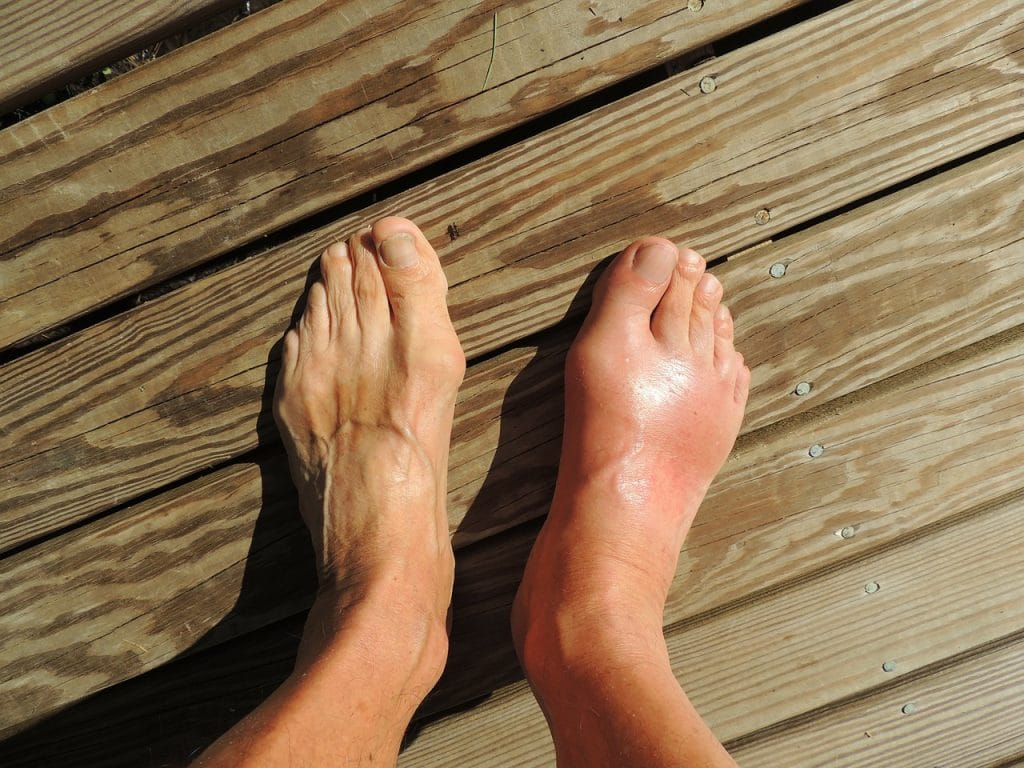
Exercise and Gout
When you’re suffering a terrible attack of gout the last thing on your mind is exercising. Even when the symptoms have abated the affected joint and muscles are still pretty stiff and you may be very wary of starting exercising again (assuming you used to exercise regularly).
But there’s a real problem here because after an attack — which may last for many days, weeks even — the affected joint and associated muscles will have become weakened such that, when your next flare-up comes around, the symptoms can be worse because of that very weakness.
So it’s important to exercise to build-up the strength of the joint and muscles again. But, more than that, it’s also important to exercise in order to help PREVENT another gout attack from occurring in the first place.
That’s what we’re going to consider today: how to use exercise to help prevent future gout attacks.
First…
What is Gout?
Gout is a form of inflammatory arthritis caused by higher-than-normal levels of uric acid in the body out of which microscopic, needle-like crystals of monosodium urate are deposited in the joints and surrounding tissue and tendons.
The body’s inflammatory response to these crystals produces the agonizing symptoms of a gout attack: inflammation, swelling, redness, stiffness, and excruciating pain.
Exercising During a Gout Attack
During an attack the joint is swollen, very stiff and extremely painful when moved. This makes it very difficult to exercise the joint.
But should you be trying to move at all? What benefit is there in trying to exercise a gouty joint?
So should you be exercising during an attack of gout?
During an actual gout flare-up the expert advice is to rest the joint as much as possible in order to help reduce the inflammation and pain. Exercise will only exacerbate the inflammation and cause more and longer-lasting pain.
And in case you’re thinking that exercise will break-up the crystals and help to remove them from the body, that’s a total myth, not borne out by the science.
So, during an actual gout attack, it’s best to elevate and rest the affected area / limb as much as possible, use hot and cold compresses, and keep taking the gout medications prescribed by your doctor.
Exercising to Help Prevent Future Gout Attacks
Although it’s not recommended to exercise in the middle of a gout attack, it’s definitely recommended that you exercise once the attack is over and the symptoms have abated.
There are several important things you should do to prevent future gout attacks. Things such as:
- move to a low purine diet
- consume less sugar
- avoid alcohol
- reduce salt intake
- lose weight
- reduce stress
- control your blood pressure
- keep properly hydrated
- get plenty of rest and sleep
Regular exercise can definitely help with at least 4 of those: losing weight, reducing stress, controlling blood pressure, and getting good rest and sleep.
All are very important in gout prevention, but losing weight is of particular importance because we know that being overweight or obese is a key determinant for gout.
So if you can get back down to a healthy weight, reduce the stress in your life, maintain healthy blood sugar levels, and get a good night’s sleep, you can help to reduce the risk of another painful gout attack.
Now, we already know that regular exercise helps to reduce weight and this is key if you’re overweight and have gout.
But exercise also produces endorphins in the brain that help to reduce stress and pain. They also improve the ability to sleep, which also reduces stress.
Regular exercise strengthens your heart muscles, making it pump more efficiently, so reducing the pressure on the walls of your arteries and lowering your blood pressure.
And, as you exercise, your muscles use more of the glucose in your bloodstream, which then helps to lower your blood sugar levels and makes the insulin in your body work more effectively. Improved insulin sensitivity has been linked to increased uric acid excretion and a lower risk of gout.
Not only that, regular daily exercise can help to strengthen your joints, build muscle, improve bone density and improve flexibility, all of which can help to reduce the severity and duration of a gout attack, should you be unfortunate enough to suffer another one.
So regular exercise is highly recommended for gout prevention.
The first thing to say is that any exercise should be low-impact and joint-friendly for someone with gout. Damaged joints and physical trauma are known to be high risk factors for gout. So take things easy; start off slowly and build-up over time.
My top 3 exercises for gout are:
Swimming.
Without a doubt the best low-impact exercise for gout patients is swimming. Try to swim at least twice a week. Not only will this improve your body composition and core it’ll also help you to lose weight. It’s also great for muscle strength and cardiovascular fitness.
Cycling.
Cycling is much better for you as a gout sufferer than running. Your feet aren’t pounding on hard surfaces and you’re reducing the risk of joint damage and trauma. As well as cardiovascular fitness, cycling’s great for muscle strength and joint mobility. It’s also excellent for relieving stress.
Walking.
Walking is less stress on the joints than running. Start of with normal walking then, over time, gradually build up to speed walking on flat terrain. Speed walking increases muscle and joint flexibility because you use a wider range of motion. Make sure you have proper walking shoes with good support.
I love these three exercises as they are so effective, not really that difficult to do, and really, really enjoyable! You may also want to consider: dancing, stair climbing, yoga, and pilates, to name but a few.
Another to give serious consideration to is core strengthening. Your core is the centre of all movement, leading to better balance and posture and less stress on joints and muscles when you’re going about your daily activities, as well as exercising.
But remember:
- Drink plenty of water while exercising as dehydration is another well-known trigger for gout.
- Don’t exercise during an actual gout flare-up; only exercise after the attack has abated.
- Exercise is only one tool for preventing gout. You also need to address your diet and lifestyle.



